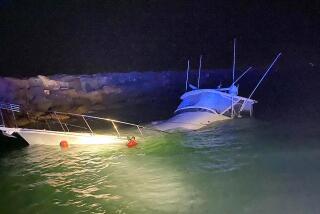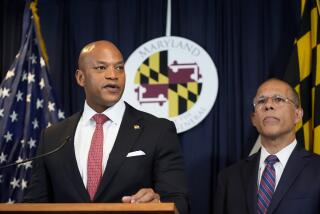Navy Partly to Blame for Fatal Boat Crash, Judge Rules
- Share via
LOS ANGELES — The U.S. Navy has for decades ignored the safety of pleasure boaters in Anaheim Bay and shares responsibility for a 1984 speedboat accident that took five lives, a federal judge ruled Thursday.
Ticking off a list of minimal safety precautions that were not taken, U.S. District Judge James M. Ideman ruled in a damage suit that the government is potentially liable for half of the more than $20 million being sought by survivors and relatives of the five dead in connection with the 1984 accident.
“It was too much trouble for the Navy. They didn’t bother to do it,” Ideman said. “The Navy didn’t give one thought to the safety of these pleasure boaters.”
The plaintiffs in the lawsuit claimed that the Navy was partly responsible for an accident involving a boat piloted by Virl Earles, 32, of Westminster because it had not properly maintained or policed waters under its authority.
Earles admitted he was driving up to five times the speed limit of 5 m.p.h. in the bay and was traveling without lights on a dark night when his boat hit an unlighted mooring buoy. A blood test showed that Earles’ blood-alcohol content was slightly above the legal limit for an automobile driver.
In August, 1986, Earles was convicted of involuntary manslaughter in the five deaths. The jurors who convicted Earles then made a special joint plea to the judge for mercy. He was sentenced to three years in state prison, but is free on appeal.
On Thursday, Ideman called Earles “extremely negligent,” finding him “drunk, or at least under the influence of alcohol.” But the Navy, by opening the bay to pleasure boaters, must expect unskilled and sometimes dangerous boating to occur and safeguard against it, Ideman said.
“If anybody had stopped for one minute to think about it, they would have known that this accident was absolutely inevitable,” Ideman said.
The Navy may have to pay Earles, too. Ideman’s ruling means the Navy could end up paying half the damages Earles can prove. Earles has claimed more than $70,000 in medical damages and lost wages alone as a result of the crash.
“I’m just glad it’s over,” said Pat Earles, Virl Earles’ mother, who tried unsuccessfully to fight back tears after Ideman announced his ruling.
“Virl has suffered a lot. Maybe it will help him.”
“We’re extremely happy,” said Earles’ wife, Lori. “It was kind of a shock. I was told not to hope for the best--not to get my hopes up.”
Earles, a mechanic and truck driver, was unavailable for comment.
An elated Neal Hirschfeld, the Houston attorney who has led a team of five lawyers for the plaintiffs, called it a “tremendous, tremendous victory.”
“If Virl was found at fault in killing these people,” Hirschfeld said, “then the United States government has been found equally at fault in killing them. Equally.”
U.S. Justice Department attorney Warren Schneider had urged Ideman to find that the accident was caused by Earles’ gross negligence, and had insisted that the bay was safe. He declined comment on Ideman’s criticism of the Navy.
Ideman did decide that each passenger in the boat--or their survivors--will receive only half of any award ultimately won in the next phase of the trial. Because they consented to riding with Earles knowing he had been drinking, their damages should be reduced by his share of the blame, the judge ruled.
The judge ruled that the Navy:
- Should have lighted the mooring buoy into which Earles crashed.
- Violated its own regulations in not licensing boaters who use the bay.
Ideman also found that posted speed limits were difficult, if not impossible, to read after dark.
The Navy could have done “many things” to increase safety in the bay, Ideman said, such as requiring proof of boating ability to enter the bay, and making inspections of boats and safety equipment such as life jackets.
Long Beach attorney Dana Denton, representing Earles in the lawsuit, said the eight buoys in the bay cost $60,000 each. Lighting would have cost just an added $1,000, Denton maintained.
The buoys still are not lighted, although the Navy did place reflective tape on the buoy that Earles’ boat hit.
Ideman’s ruling drew no immediate response from officials of the Seal Beach Naval Weapons Station, which runs Anaheim Bay as a military facility classified as “dangerous” because of ammunition transfers.
“Since we haven’t received the official word, and since our attorneys haven’t conferred with each other, it makes it really difficult for me to say anything,” said Tracey Schwarze, public affairs officer for the station.
One Ideman suggestion--that the Navy shut the bay off except to boaters it licenses--would probably cause an “uproar” in nearby Huntington Harbour, Schwarze said.
Further Proceedings
An estimated 40,000 “transits”--one-way trips across the bay--are made by pleasure boaters each year, according to testimony in the case.
Ideman scheduled further proceedings in April to determine how much should be awarded in damages against the Navy.
Last week, a former security guard at the weapons station testified that he had recommended lighting the buoys a year before the accident, but that the Navy said there was no need. The guard made the suggestion because some boaters, confused by lights around the bay after dark, actually ran up on the beach.
Plaintiffs in the case include Earles and the five victims’ parents: Terez Ujj, mother of John Bakos, 20, of Paramount; Robert Weaver and Estelle Schmidt, parents of Kathy Weaver, 24, of Long Beach; Marlene Sutton, mother of Anthony Sutton, 27; Marie Katz, mother of Ronnie Myers, 22, and Roberta Huling, mother of Patricia Huling, 20, of Laguna Hills.
Three others besides Earles survived the crash of the 20-foot fiberglass boat named the Whiskey Runner. They are Stephen Brennan, then 24, of Huntington Beach; Ernest Chavez, then 25, of Bakersfield, and Carol Kemble, then 25, of Laguna Beach.
Sutton, of Irvine, who was present when Ideman announced his decision, wept openly. Her son, who shared an apartment with Earles, was his “best friend,” she said.
“I just think it will maybe be the key to keep them (the Navy) from letting it happen to anybody else,” Sutton said. “I wouldn’t want any other mother to go through this.”
More to Read
Sign up for Essential California
The most important California stories and recommendations in your inbox every morning.
You may occasionally receive promotional content from the Los Angeles Times.













